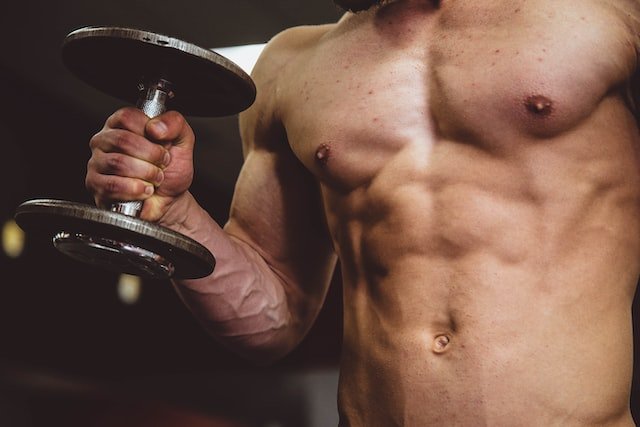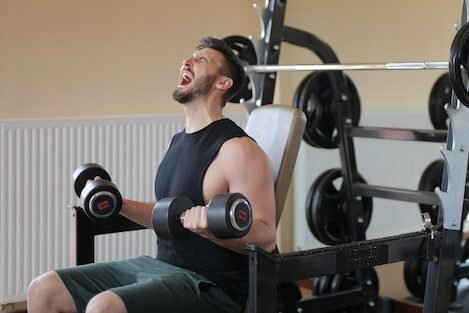
Thumb Pain Doing Dumbbell Curls? 12 Vital Things To Consider
Wondering why your thumb hurts after doing curls? You’re not alone. A lot of people experience pain in their thumbs when doing dumbbell curls, and it can be really frustrating.
It leaves you to ask “Why do I get thumb pain doing dumbbell curls?”
There are actually a few different reasons why this might be happening and it can be frustrating to try to figure out what’s causing the pain.
In this post, we’ll take a look at what’s causing the pain and how to fix it.
Why Do I Get Thumb Pain Doing Dumbbell Curls?
Getting thumb pain during dumbbell curls can be caused by a few different things. Gripping the dumbbell too tightly is a common mistake that people make when they are first starting to lift weights. They grip the dumbbell too tightly in their hand and this puts a lot of pressure on the thumb. Another common mistake is using a weight that is too heavy for you. This can cause the thumb to get strained and can also lead to pain. Not using the proper form is probably the most common reason for thumb pain during dumbbell curls. If you are not using the proper form, then you are putting a lot of strain on your thumb. If, for example, the handle is positioned too low on your palm and digs into your thenar, you’ll experience a lot of pain. If you have ligament issues, or if you are extending your wrist at the top of the curl, this can also lead to thumb pain.
What are the different types of curls?
When doing dumbbell curls, it’s important to use the right grip. The most common grip is the supinated or underhand grip. This is when your palms are facing up as you curl the weight.
The next grip is the pronated or overhand grip. This is when your palms are facing down as you curl the weight.
Then the neutral grip. This is when your palms are facing each other as you curl the weight, you may also know this as a hammer curl.
There are rope attachment curls, incline curls, and preacher curls too.
Lets now look at the reasons you are getting thumb pain and ways to fix it.
Gripping the Dumbbell Too Tightly
If you are gripping the dumbbell too tightly in your hand, this puts a lot of pressure on the thumb and can lead to pain. When first starting to lift weights, people often grip the dumbbell too tightly because they are afraid of dropping it.
Although it is crucial to have a firm grip on the dumbbell, gripping it too tightly may cause more damage in the long run.
A good way to know if you are gripping the handle too tight would be in how your forearms feel the next day. If your forearms are very sore, then you were likely gripping too tight.
Gripping the handle too tight will also lead to tension going all the way up your arm and even going into your neck and shoulders. So not only will you experience thumb pain, but you may also get neck and shoulder pain as well.
If you find that your grip is too tight, try relaxing it to see if the pain decreases. If there is no change, then experiment with changing your grip until you find a comfortable one.
Using a Weight That is Too Heavy
If you are using a weight that is too heavy for you, this can lead to thumb pain as well. When the weight is too heavy, it can strain the muscles and tendons around the thumb joint and cause pain.
If you are using a weight that is too heavy, you will likely also notice that your form starts to suffer. This is because your body is not strong enough to handle the weight and you start to compensate by using poor form.
If you think that the weight you are using is too heavy, try reducing the weight and see if the pain goes away. If it does, then you were likely using a weight that was too heavy for you.
We all want to lift as heavy as possible, but it is important to make sure that you are using a weight that you can handle.
Lifting too heavy can lead to injuries, so be sure to start light and gradually increase the weight as you get stronger.

Not Using Proper Form
Not using proper form is probably the most common reason for thumb pain during dumbbell curls. If you are not using the proper form, then you are putting a lot of strain on your thumb.
There are a few different things that can cause poor form. One is using a weight that is too heavy for you (we already talked about this). The other is not keeping your wrist in the correct position.
When doing dumbbell curls, you want to keep your wrist in a neutral position. This means that your palm should be facing your shoulder at the bottom of the curl and your thumb should be pointing up.
If your wrist starts to deviate from this position, then you are putting unnecessary strain on your thumb. This can lead to pain and even injuries.
So be sure to keep your wrist in a neutral position and use a weight that you can handle. If you are unsure about your form, then seek out the help of a qualified personal trainer.
Wrist extension
One of the motions your wrist can make is called extension. This is when you bend your wrist backwards away from your palm.
Doing too much wrist extension during dumbbell curls can lead to thumb pain. This is because you are putting unnecessary strain on the muscles and tendons around your thumb joint.
The ligaments that connect your thumb to your hand can also be put under a lot of strain, which can lead to pain.
To avoid this, be sure to keep your wrist in a neutral position and don’t extend it too far backwards. This normally happens when you are curling too much weight, due to your wrists extending to finish the job.
Related: Why Do I Feel Bicep Curls In My Triceps? Problem Solved For Rapid Results
Ligament problems?
If you experience thumb pain during dumbbell curls, it could be due to a ligament problem. The ligaments that connect your thumb to your hand can be put under a lot of strain, which can lead to pain.
One way to tell if this is the case is if you have difficulty moving your thumb. If you find that your thumb is stiff and painful, then it is likely due to a ligament problem.
Make sure you rest and ice the area to reduce inflammation. You can also take over-the-counter pain medication to help relieve the pain. If the pain is severe, you may need to see a doctor for further treatment.
If you think you may have a ligament problem, then you should see a doctor or physiotherapist. They will be able to diagnose the problem and give you the proper treatment.
Carpal tunnel syndrome
Carpal tunnel syndrome is a condition that can cause thumb pain during dumbbell curls. It is caused by compression of the nerves in your wrist.
The symptoms of carpal tunnel syndrome include tingling, numbness, and weakness in the hand and fingers. If you experience these symptoms, then it is important to see a doctor.
Carpal tunnel syndrome is treated with a combination of rest, ice, and splinting. Surgery may also be required in severe cases.

Is the handle digging into the thumb?
The thenar muscles are the muscles that make up the fleshy part of your palm. If you find that the handle of the dumbbell is digging into this muscle, then it can cause pain.
One way to avoid this is to use a weight that is not too heavy for you. If you are using a weight that is too heavy, then your grip will not be as strong and the handle can start to dig into your palm.
Another way to avoid this is to use a dumbbell with a thicker handle. This will distribute the weight more evenly and will not put as much pressure on your thenar muscle.
If you find that the handle is still digging into your palm, then you can try using a lifting strap. This will help take some of the pressure off of your hand and will make it easier to grip the dumbbell.
When using a lifting strap, be sure to wrap it around the part of the dumbbell that is closest to your wrist. This will help prevent the dumbbell from slipping out of your hand.
Related: Are Bicep Curls a Pain In your Neck? Answers For Pain Relief And Progress Here
Handle placement
The placement of your hand on the dumbbell handle can also affect thumb pain. If you grip the dumbbell in the wrong part of your hand, it can hurt.
Gripping the dumbbell too close to the end can put unnecessary strain on your thumb. The further away from the end of the dumbbell, you grip it, the less strain there will be on your thumb.
Where the handle sits on your palm can also have an effect. If the handle is too close to your wrist, then it can put strain on your thumb. The further away from your wrist, the better.
If you find that the dumbbell is still causing pain, then you can try using a lifting glove. This will help take some of the pressure off of your hand and will make it easier to grip the dumbbell.
When using a lifting glove, be sure to choose one that fits snugly. This will help prevent the dumbbell from slipping out of your hand.
Another thing to keep in mind is the width of your grip. If you grip the dumbbell too wide, then it can put a strain on your wrist and forearm. This can lead to pain in the thumb joint.
To avoid this, be sure to grip the dumbbell in the middle of your hand. This will help take some of the pressure off of your wrist and forearm.
Not warming up?
If you are not properly warming up before working out, then you may be more likely to experience pain with any given exercise you are doing.
Be sure to warm up for at least 5-10 minutes before starting your workout. This will help prepare your body for the exercise and will reduce the risk of injury.
if you experience pain in your thumb when doing curls, try doing some specific hand and forearm exercises to warm up. These exercises will help blood flow to your muscles and will reduce the risk of injury.
One such exercise is to make a fist and then open your hand as wide as you can. Repeat this 10-15 times. Another exercise is to grip a tennis ball or stress ball and squeeze it as hard as you can. Hold this for 5 seconds and then release. Repeat this 10-15 times.
Doing these exercises before working out will help reduce the risk of thumb pain during dumbbell curls.
Overtraining?
If you find that you are experiencing pain in your thumb after working out, then you may be overtraining.
Overtraining occurs when you work out too frequently or for too long without allowing your body adequate time to recover. This can lead to muscle soreness, fatigue, and injury.
If you think you may be overtraining, then take a few days off from working out to allow your body to recover.
The thumb pain might not be from curls specifically, but from the fact, you have been working out a lot recently and the curls are just the straw that broke the camel’s back, so to speak.
If the pain persists, then you may need to consult a doctor or physical therapist to determine the cause of the pain.
Related: Why Is One Arm Stronger Than The Other? (All The Answers For Perfect Symmetry)
Do you play video games?
One potential cause of thumb pain is De Quervain’s tenosynovitis. This condition is caused by the overuse of the thumb muscles and tendons.
De Quervain’s tenosynovitis is common in people who play a lot of video games. The constant use of the thumb muscles and tendons can lead to inflammation and pain.
If you think you may have De Quervain’s tenosynovitis, then you should see a doctor. They will be able to diagnose the condition and recommend treatment.
Treatment for De Quervain’s tenosynovitis typically involves resting the thumb and wearing a splint or brace. Physical therapy may also be recommended to help stretch and strengthen the muscles and tendons around the thumb.
If you have De Quervain’s tenosynovitis, then it is important to rest your thumb and avoid activities that exacerbate the condition. This includes playing video games, texting, and using a computer mouse.

Final thoughts…
If you experience thumb pain during dumbbell curls, then there are a few different things that could be causing it. Be sure to use proper form and grip the dumbbell lightly to avoid putting unnecessary strain on your thumb.
Use a weight that you can handle and don’t extend your wrist too far backwards. If the pain persists, then you may need to consult a doctor or physical therapist to determine the cause of the pain.
In the meantime, try doing some specific hand and forearm exercises to warm up before working out. This will help reduce the risk of thumb pain during dumbbell curls.
Have you experienced this problem when doing curls? Let us know how these tips worked for you in the comments below!


